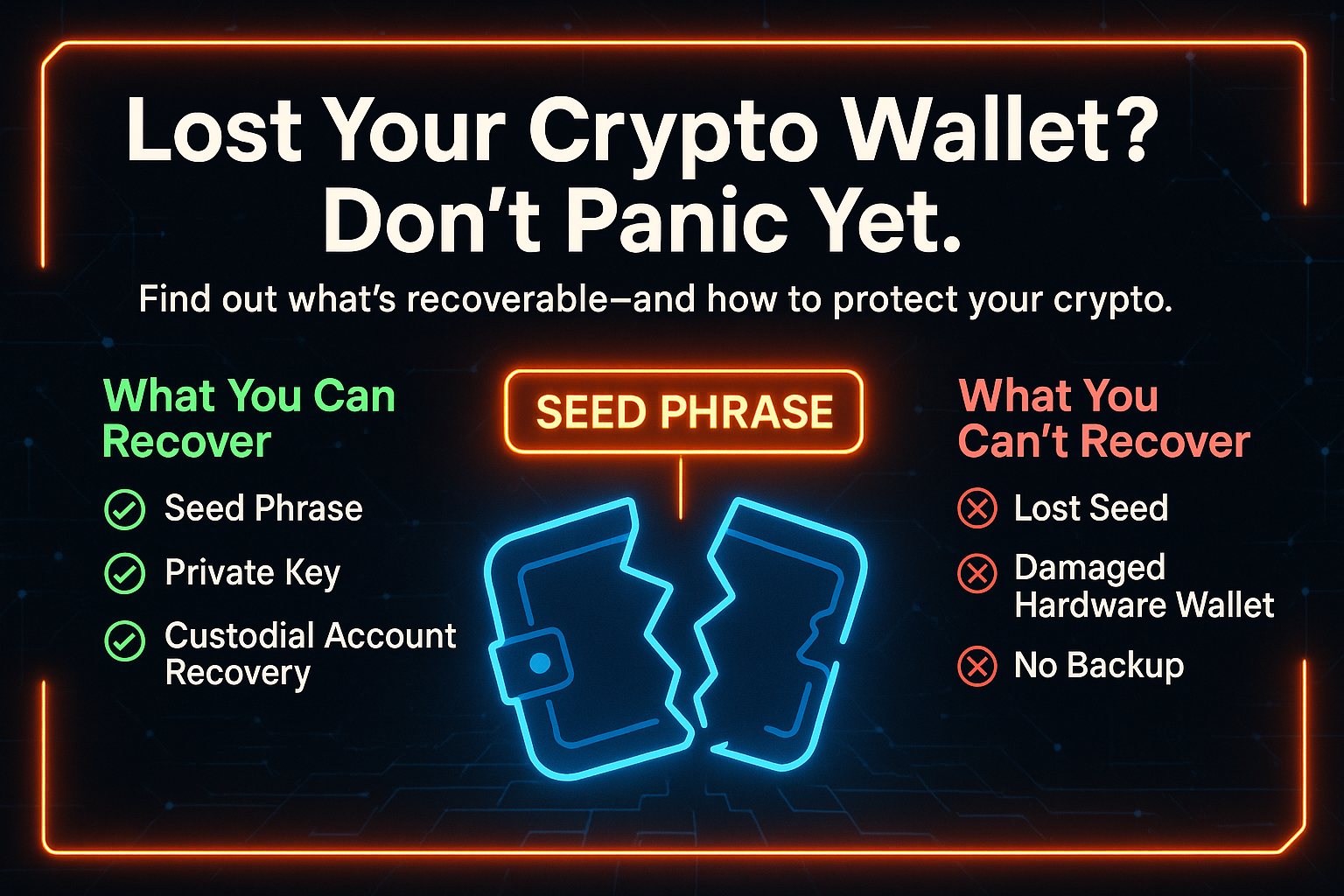What You Can Recover
Cryptocurrency can be empowering, but it also comes with high responsibility. Unlike traditional banking, losing access to your crypto wallet may mean losing your funds forever. If you’ve lost your wallet or private keys, don’t panic just yet. Here's a breakdown of what you can and can't recover, and how to avoid common key management mistakes in the future.
First, What Is a Crypto Wallet?
A crypto wallet is a digital tool that stores your private keys, which are essential for accessing and managing your cryptocurrency. There are two main types:
- Hot wallets: Software-based and connected to the internet (e.g., MetaMask, Trust Wallet)
- Cold wallets: Hardware or paper-based and offline (e.g., Ledger, Trezor)
Your coins aren’t stored in the wallet itself, but on the blockchain. The wallet just lets you access them—if you have the right private key.
Learn More About: Crypto Wallets: A Guide to Storage Options and Security
Can You Recover a Lost Crypto Wallet?
Whether you can recover a lost wallet depends on what exactly was lost and how you managed your keys and backups. Let's break it down:
✅ You Can Recover If:
1. You Still Have Your Recovery Phrase or Seed Phrase
This is the master key. Most wallets provide a 12- or 24-word seed phrase during setup. If you have this securely stored, you can restore your wallet on any compatible wallet app.
✅ Recovery Tip: Use your seed phrase on a trusted wallet app to regain access. Ensure you're on the official site or app to avoid phishing scams.
2. You Have a Backup of Your Private Keys or Keystore File
Some wallets let you export and save your private key or an encrypted keystore file. If you have these along with the correct password, your funds can be recovered.
3. Your Wallet Is Synced to a Cloud Account (for Custodial Wallets)
Some custodial wallets (like Coinbase or Binance) allow you to recover access through email/password or 2FA recovery. These wallets store your keys for you.
🔒 Caution: Custodial wallets are more user-friendly but less decentralized. You’re trusting a third party with your keys.
❌ You Can’t Recover If:
1. You’ve Lost Both the Wallet and Recovery Phrase
Without the recovery phrase or private keys, there is no way to access the funds. Blockchain transactions are irreversible, and no central authority can unlock your wallet.
2. Your Hardware Wallet Is Damaged and You Have No Backup
If a hardware wallet breaks and you haven’t backed up the recovery phrase elsewhere, the funds are likely lost forever.
3. You Forgot Your Password to an Encrypted Wallet File Without Recovery Phrase
Some software wallets encrypt your private keys with a password. Without the password and seed phrase, recovery becomes nearly impossible.
Common Key Management Mistakes (and How to Avoid Them)
Learn More: 5 Mistake you must avoid if you want to Become a Millionaire
Mismanaging your wallet credentials is the top reason people lose access to their crypto. Here are common mistakes and how to fix them:
🚫 Mistake 1: Not Backing Up Your Seed Phrase
Many users skip writing down their seed phrase or store it in a screenshot or digital note—risky and insecure.
✅ Solution: Write it down and store it in a fireproof, waterproof safe. Consider using metal backup tools for long-term durability.
🚫 Mistake 2: Storing Keys Online
Keeping private keys in cloud storage (e.g., Google Drive, iCloud) can expose them to hackers.
✅ Solution: Use offline storage or a hardware wallet. Never share or upload private keys online.
🚫 Mistake 3: Losing Track of Wallet Details
Some users use multiple wallets and forget which one holds which coins or keys.
✅ Solution: Maintain a secure, offline log (notebook or encrypted USB) of wallet names, addresses, and key locations.
🚫 Mistake 4: Trusting Unknown Recovery Services
Scammers often pose as recovery experts. If someone asks for your seed phrase, it's a scam.
✅ Solution: Only use official support channels from wallet providers. Never share your private keys or seed phrase with anyone.
What to Do If You’ve Lost Access
If you believe your wallet is lost, take these steps:
- Stop and Assess: Identify the wallet type (hardware/software/custodial) and what info you still have.
- Search for Backups: Look through your documents, safe places, and password managers for recovery phrases or private keys.
- Try Recovery Tools: Some advanced users use wallet recovery software—but these require technical knowledge and caution.
- Contact Support: For custodial wallets, reach out to the platform’s customer service immediately.
Future-Proof Your Crypto
The best time to think about wallet recovery is before something goes wrong. Follow these best practices:
- Use a hardware wallet for large holdings.
- Always back up your recovery phrase—twice.
- Consider multisig wallets for added security.
- Use a password manager to store encrypted wallet metadata (not your seed phrase).
Final Thoughts
Losing access to your crypto wallet can feel devastating, but not all is lost if you’ve taken the right precautions. The key lies in understanding what can and can’t be recovered, avoiding common key management mistakes, and setting up a solid security strategy moving forward.


Post a Comment